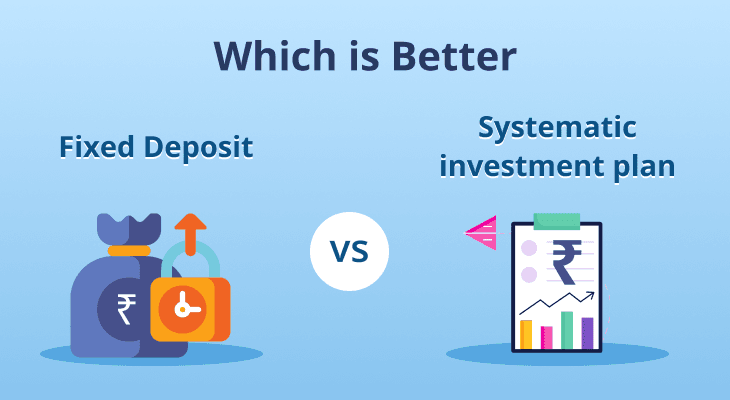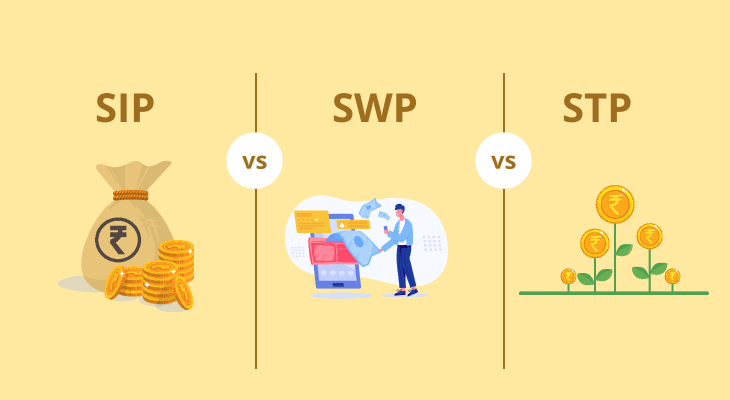
FD vs SIP - Which is Better
Investing your hard-earned money wisely is vital for successful financial planning and for ensuring a stable financial future. While there are multiple investment options available in the market, Fixed Deposits (FDs) and Systematic Investment Plans (SIPs) stand out for their unique benefits and popularity. Fixed deposits have long been popular among risk-averse investors due to their steady returns. SIPs, a type of mutual fund investment, present an opportunity for higher returns by utilising the influence of the stock market. But, choosing between FD vs SIP requires understanding their distinctive features, advantages, and risks. Let’s find out more.
What is SIP?
A Systematic Investment Plan (SIP) is an approach to making disciplined investments in mutual funds. It entails investing a set amount of money in a mutual fund scheme on a regular basis, usually monthly. This strategy allows investors to create a significant corpus over time without requiring a substantial initial investment.
SIPs are incredibly flexible, allowing you to start with as little as ₹500. The invested sum is used to purchase units in the mutual fund scheme, and the number of units bought is determined by the fund's Net Asset Value (NAV) at the time of investment. SIPs benefit from compounding and rupee cost averaging, making them an attractive option for long-term wealth growth.
What is FD?
Fixed Deposits (FDs) are a conventional investment option provided by banks and Non-Banking Financial Companies (NBFCs). It entails making a lump sum deposit for a specific amount of time at a fixed interest rate. FDs are recognised for their safety and guaranteed returns, making them a popular choice among conservative investors.
The interest rate on FDs is determined at the time of investment and remains constant over the term. This gives you transparency regarding the returns you'll receive. FDs can have a range of tenures, from a few days to several years, and you can choose to get regular interest payouts or reinvest your money to benefit from compounding.
Benefits of FD
Safety and Security:
FDs are regarded as one of the safest investment alternatives since they are unaffected by market volatility. The capital and interest are guaranteed, making this a low-risk investment.
Fixed Returns:
The interest rate on FDs is set at the time of investment, resulting in predictable and steady returns. This aids in financial planning because you know exactly how much you will get upon maturity.
Flexibility in Tenure:
FDs let you term of tenure that corresponds to your financial goals. Depending on your requirements, you can choose between short-term and long-term fixed deposits.
Regular Income:
FDs offer the option of receiving regular interest payments, which can be monthly, quarterly, or yearly. As a result, they are an excellent option for anyone seeking a consistent source of income.
Tax Benefits:
Section 80C of the Income Tax Act provides tax benefits for specific types of FDs, including tax-saving FDs.
Benefits of SIP
Disciplined Investing:
SIPs encourage disciplined investment by requiring regular payments. This promotes saving habits and provides constant investment regardless of market conditions.
Power of Compounding:
SIPs make use of compounding, in which returns are reinvested to create greater profits. Over time, this increases the growth of your investment.
Rupee Cost Averaging:
By investing a specific amount at intervals, SIPs profit from rupee cost averaging. This means that you acquire more units while prices are low and fewer units when prices are high, resulting in an average cost of investment.
Flexibility and Convenience:
SIPs are extremely flexible, enabling you to begin with a small amount and raise it over time. You may also specify the frequency of your investments, such as monthly, quarterly, or weekly.
Higher Returns:
SIPs invest in market tracking mutual funds. Compared to FDs, this is riskier, but it also offers the potential for higher returns, especially over the long run.
Difference Between SIP and FD
Investment Amount
FD: Requires initial lump sum investment. The minimum amount varies per the bank or NBFC but usually starts at ₹1000.
SIP: Allow for small, regular investments. You may start with just ₹500 per month.
Interest Rate
FD: FDs provide a set interest rate at the time of investment. This rate remains steady during the duration.
SIP: Returns are market-linked and based on the performance of the mutual fund scheme. There are no set interest rates.
Liquidity
FD: Funds are locked in for a specific term. Premature withdrawal is possible but it may result in fines and lower interest rates.
SIP: SIP is more liquid since mutual funds can be redeemed at any moment. Certain exit loads, however, may apply if withdrawn before a specific time period.
Risk Involved
FD: Low risk as returns are assured and not affected by market changes.
SIP: Increased risk due to market volatility. The value of investments might change according to market conditions.
Returns
FD: Provides fixed returns, offering stability and predictability. Returns are typically lower compared to market-linked instruments.
SIP: Potential for larger returns, particularly in the long run. Returns vary based on the mutual fund's performance.
Tenure
FD: FD is suitable for both short and long-term goals. You can select a duration that ranges from a few days to several years.
SIP: SIPs are ideal for medium- to long-term targets. To fully utilise the benefits of compounding and market growth, the recommended duration is often five years or longer.
Conclusion
The decision between FD and SIP is based on your financial objectives, risk tolerance, and investment horizon. Fixed deposits are ideal for conservative investors looking for stability and assured returns. They provide consistency and are best suited for short to medium-term goals. SIPs, on the other hand, are better suited to individuals who are ready to accept some risk in exchange for the potential of greater returns. They promote disciplined investment and are great for long-term wealth building. Finally, a balanced strategy that combines both FDs and SIPs in your investing portfolio will help you meet your financial targets while effectively minimising risk.
SIPs let you invest small amounts regularly, making it easier to stay consistent with your goals. With time, your money grows faster through compounding, helping you get the most out of your investments. Try our SIP Calculator to see how your money can grow and make smarter plans for your future.
FAQ
What is the minimum amount needed to start a SIP?
Starting a SIP requires only ₹500 per month. This makes SIPs an appropriate investment choice for people of all income levels, allowing you to build your wealth gradually over time.
Can I withdraw money from a SIP at any time?
Yes, you can withdraw funds from a SIP at any time. However, keep in mind that some mutual funds may charge exit loads if you redeem your investment before the specified period. SIPs are intended to be flexible, giving you the liquidity to access your funds when required.
Is interest on FDs taxable?
Yes, interest on fixed deposits (FDs) is taxable. It is added to your overall income and taxed based on your income tax bracket. This is a key consideration when comparing FDs and SIPs since tax implications might have an impact on your overall results.
Which is safer, FD or SIP?
Fixed deposits (FDs) are typically seen as safer than SIPs. FDs provide assured returns and are not subject to market risk. SIPs, on the other hand, require investing in mutual funds, which are related to market performance and might be more volatile. As a result, if you prefer low-risk investments, FDs may be a better option for you.
What is a typical tenure for SIP investments?
SIPs are best suited for medium to long-term investing goals. SIPs are typically advised for a minimum of five years. This longer duration allows you to take advantage of compounding and ride out market changes, perhaps resulting in higher returns over time.
Can I modify the SIP amount once I start it?
Yes, you may adjust the SIP amount once you've started it. SIPs are adaptable, allowing you to raise or reduce your investment based on your financial condition and objectives. One of the primary advantages of FD over SIP is its flexibility.
Do FDs provide tax benefits?
Certain types of FDs, such as tax-saving FDs, provide tax advantages under Section 80C of the Income Tax Act. However, the interest generated on these FDs remains taxable. When picking between FD and SIP, it is important to analyse the tax advantages and implications of each option.
How are the SIP returns calculated?
SIP returns are determined using the performance of the mutual fund scheme and units acquired at various NAVs (Net Asset Values). The returns might fluctuate based on market circumstances, making SIPs a potentially higher-yielding but higher-risk investment than fixed deposits.
Is there a penalty for the premature withdrawal of FDs?
Yes, there may be penalties for premature withdrawal of FDs. If you withdraw your FD before the maturity date, you may face a penalty, and the interest rate may be lower than originally agreed upon. This is a significant difference between SIPs and FDs when comparing them in terms of liquidity.
How can I compare the returns on FDs vs SIPs?
An FD vs SIP calculator is a handy tool for comparing the prospective returns on Fixed Deposits and Systematic Investment Plans. By feeding information such as the investment amount, duration, and estimated rate of return, the calculator gives a clear comparison of the returns on both investment alternatives.


